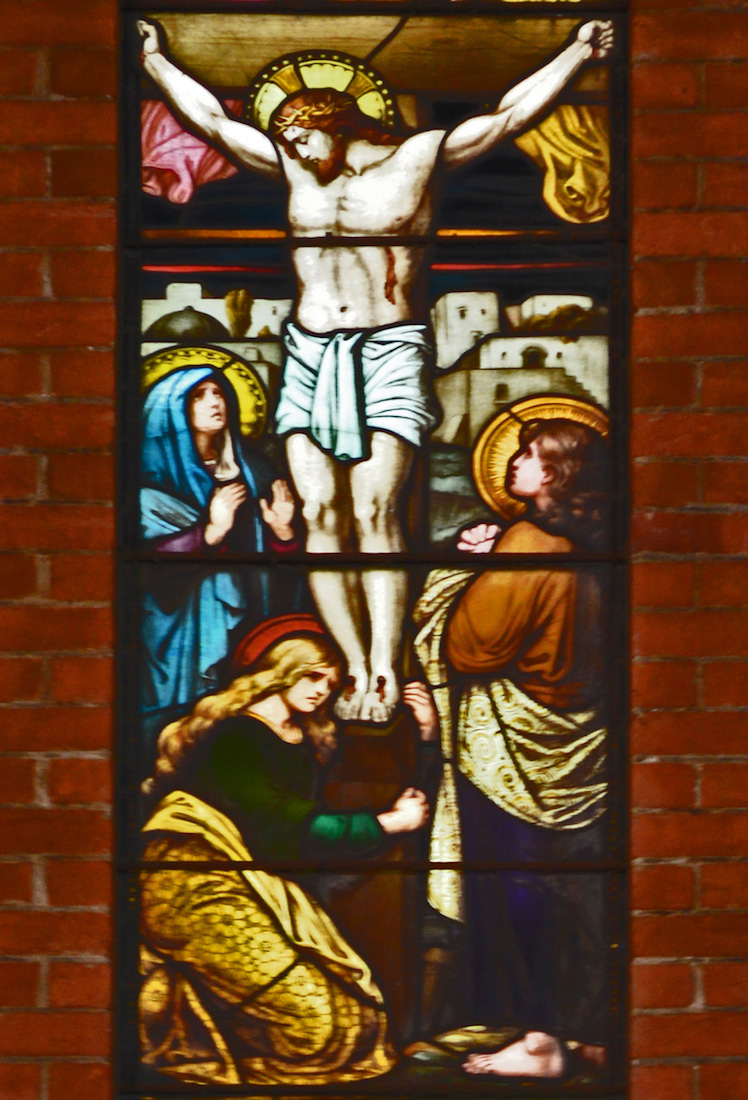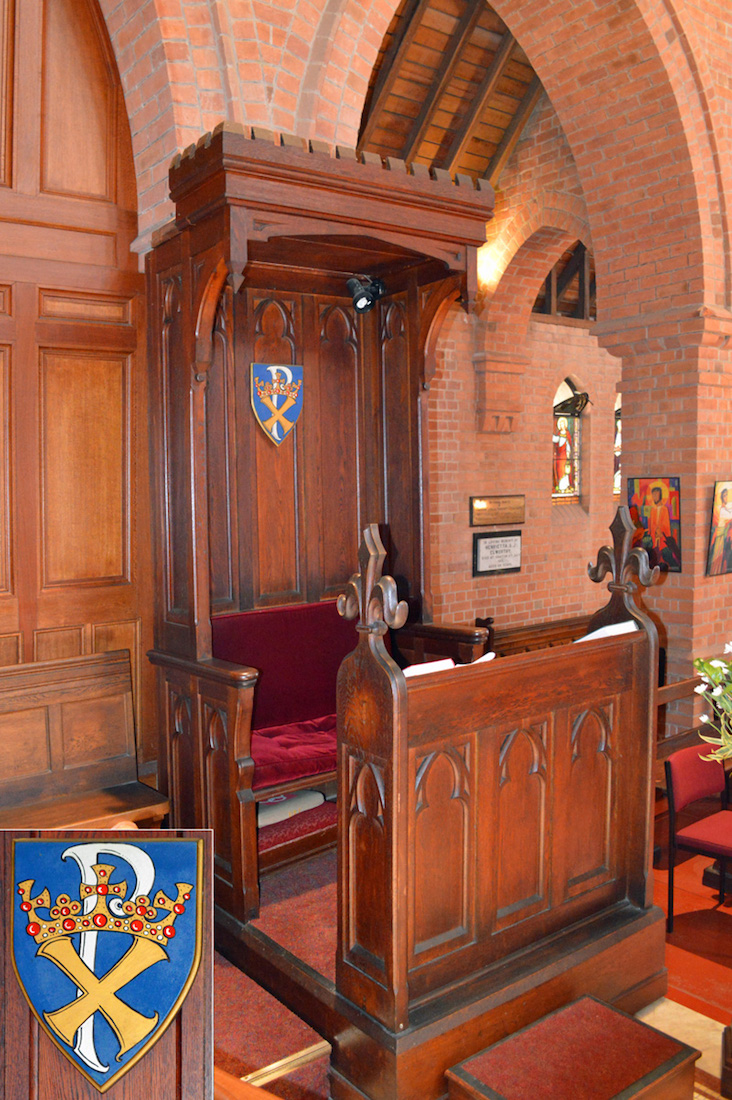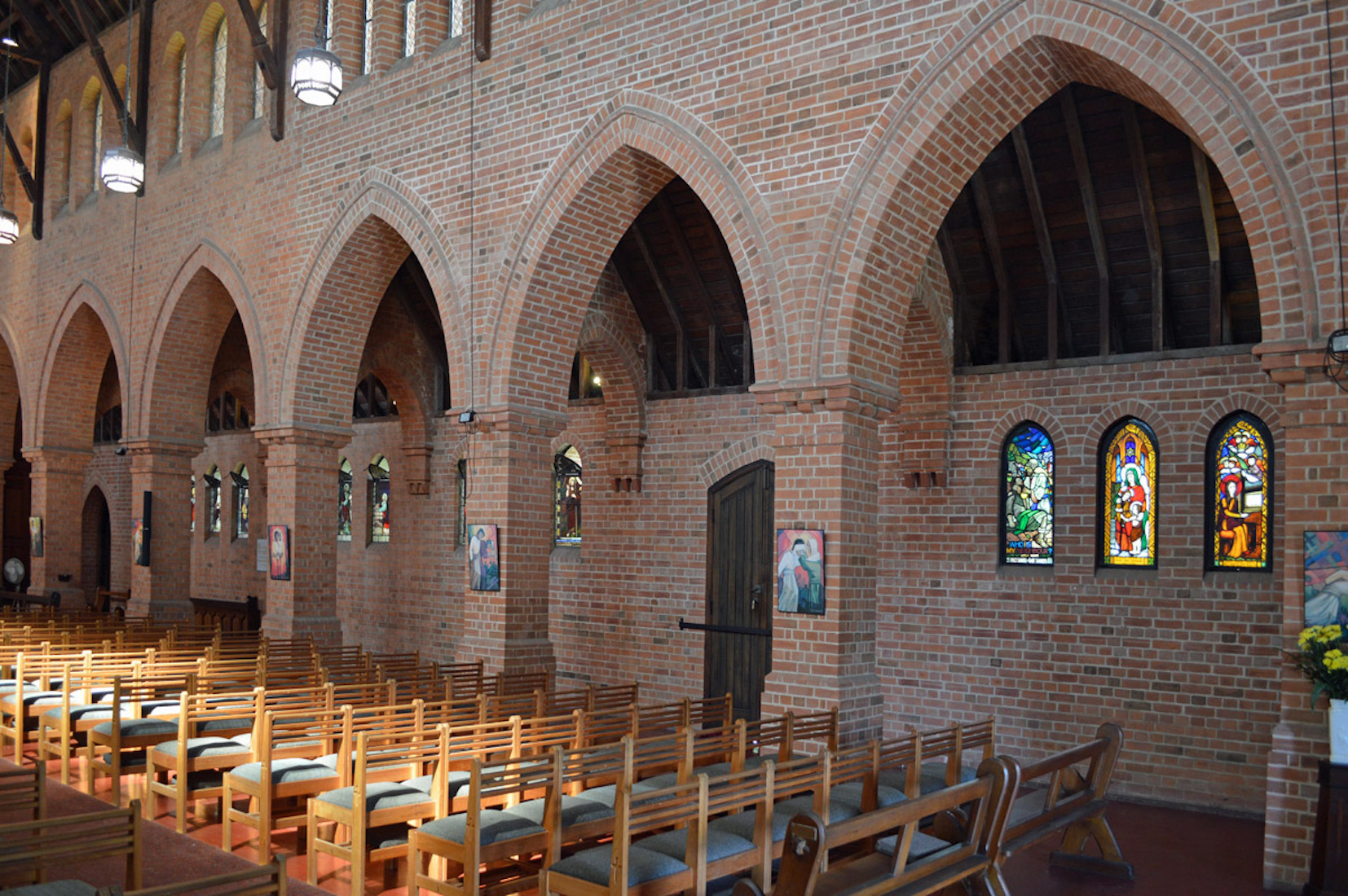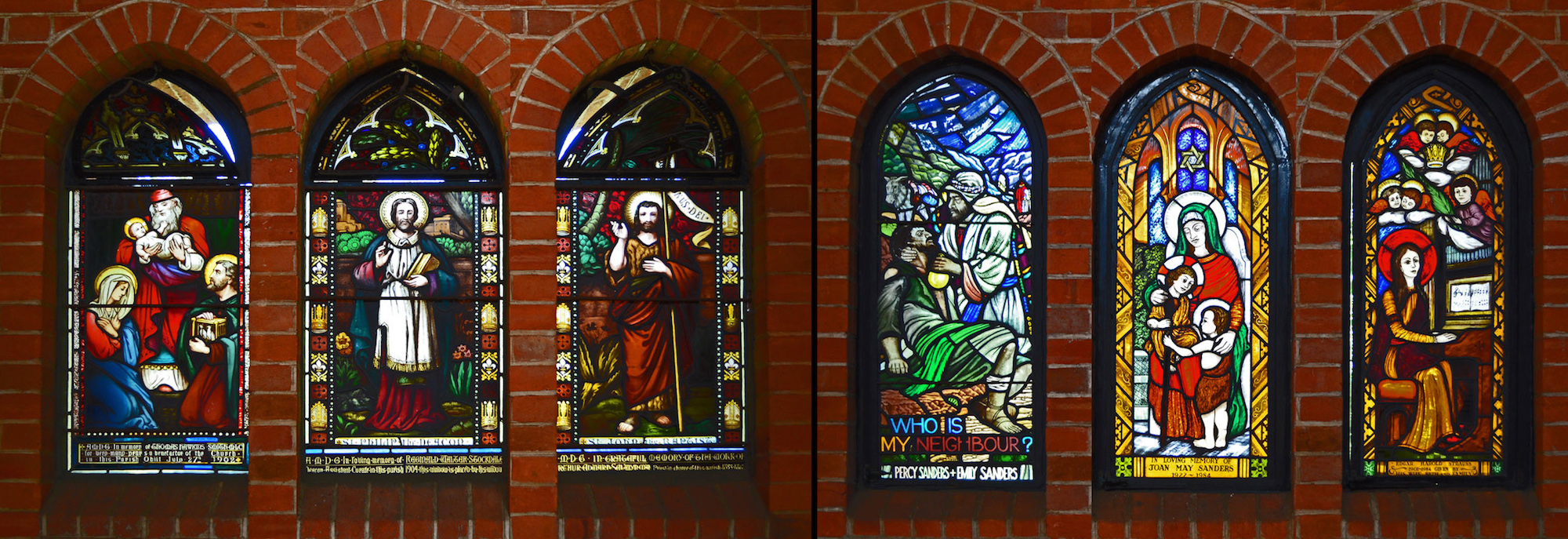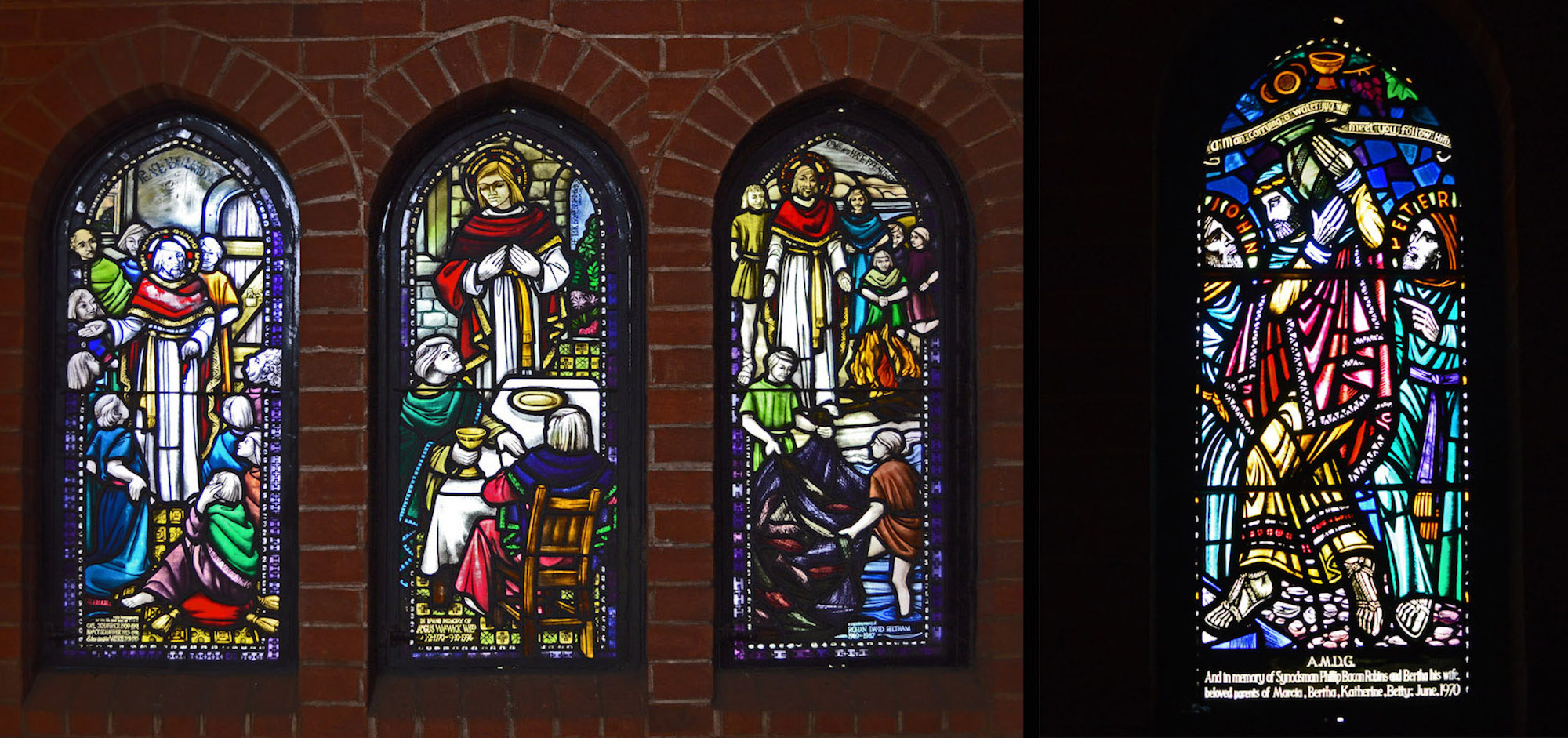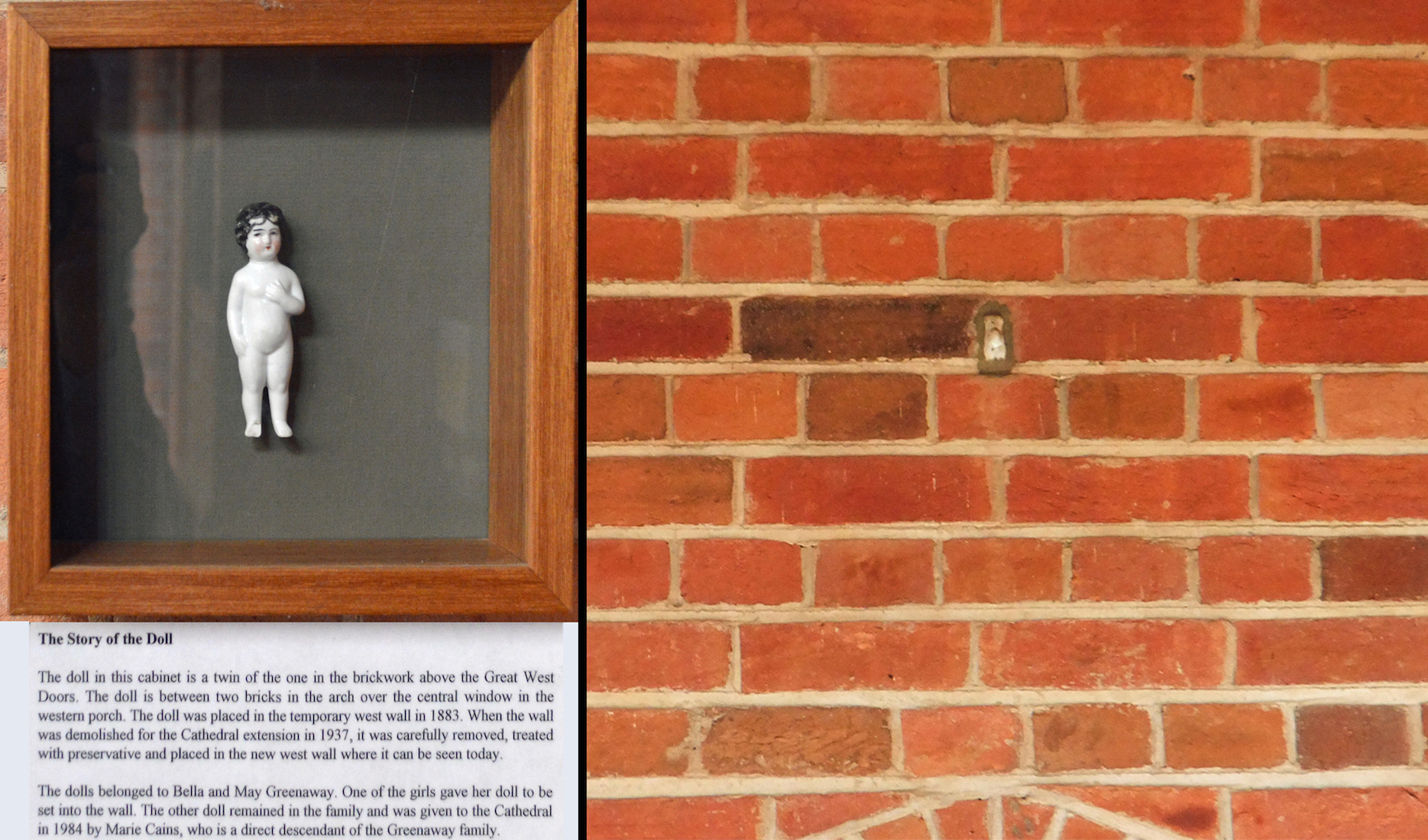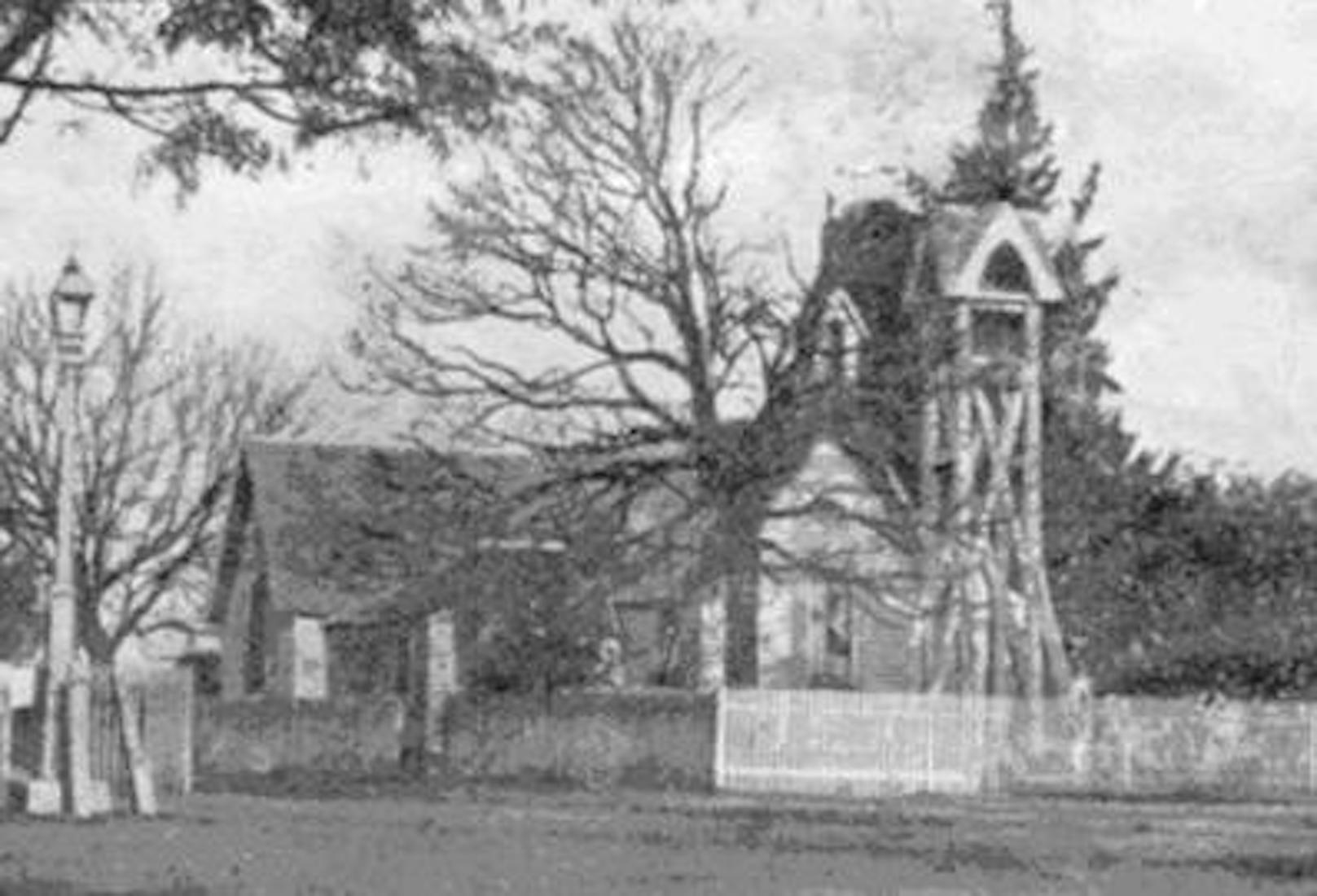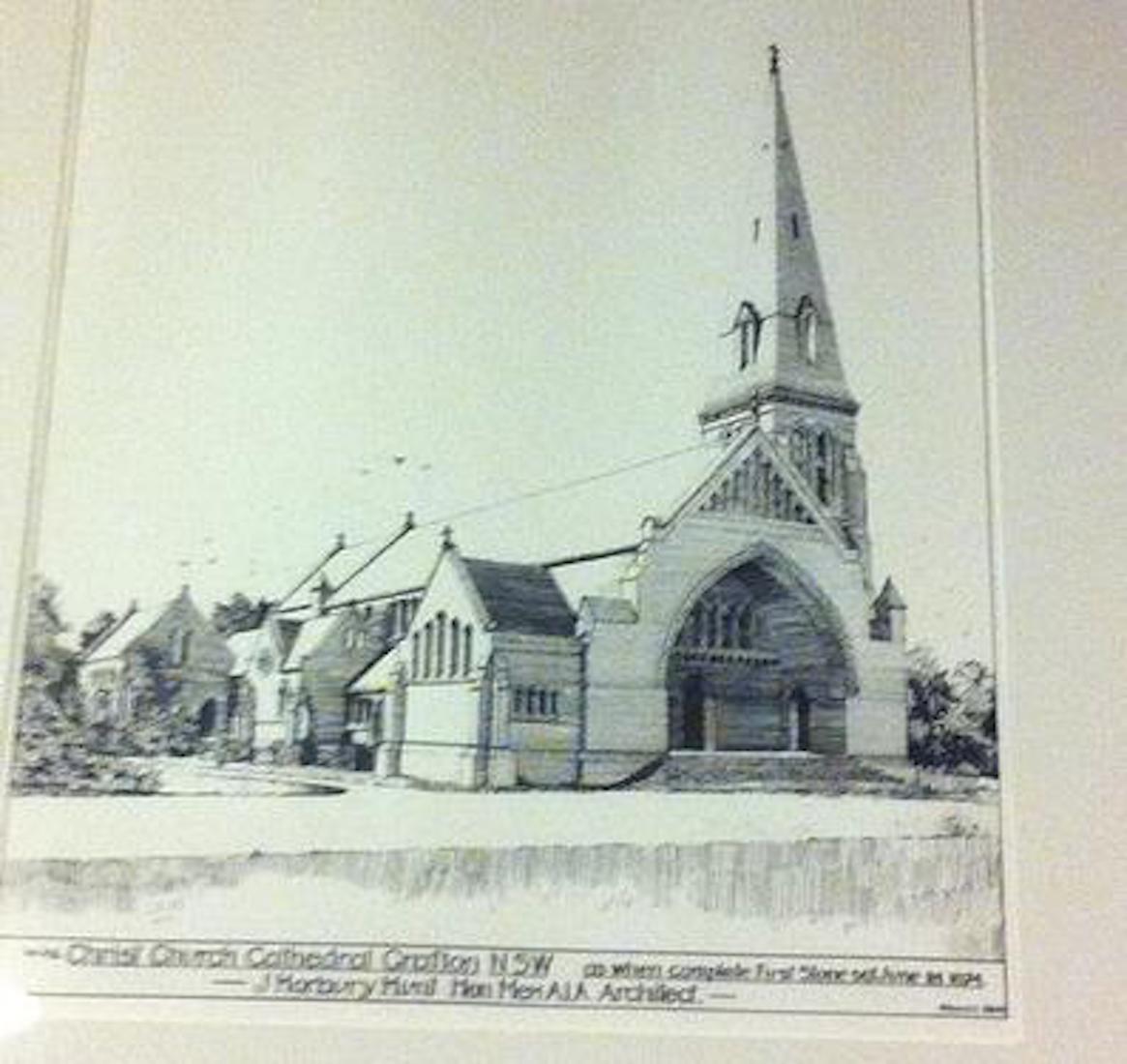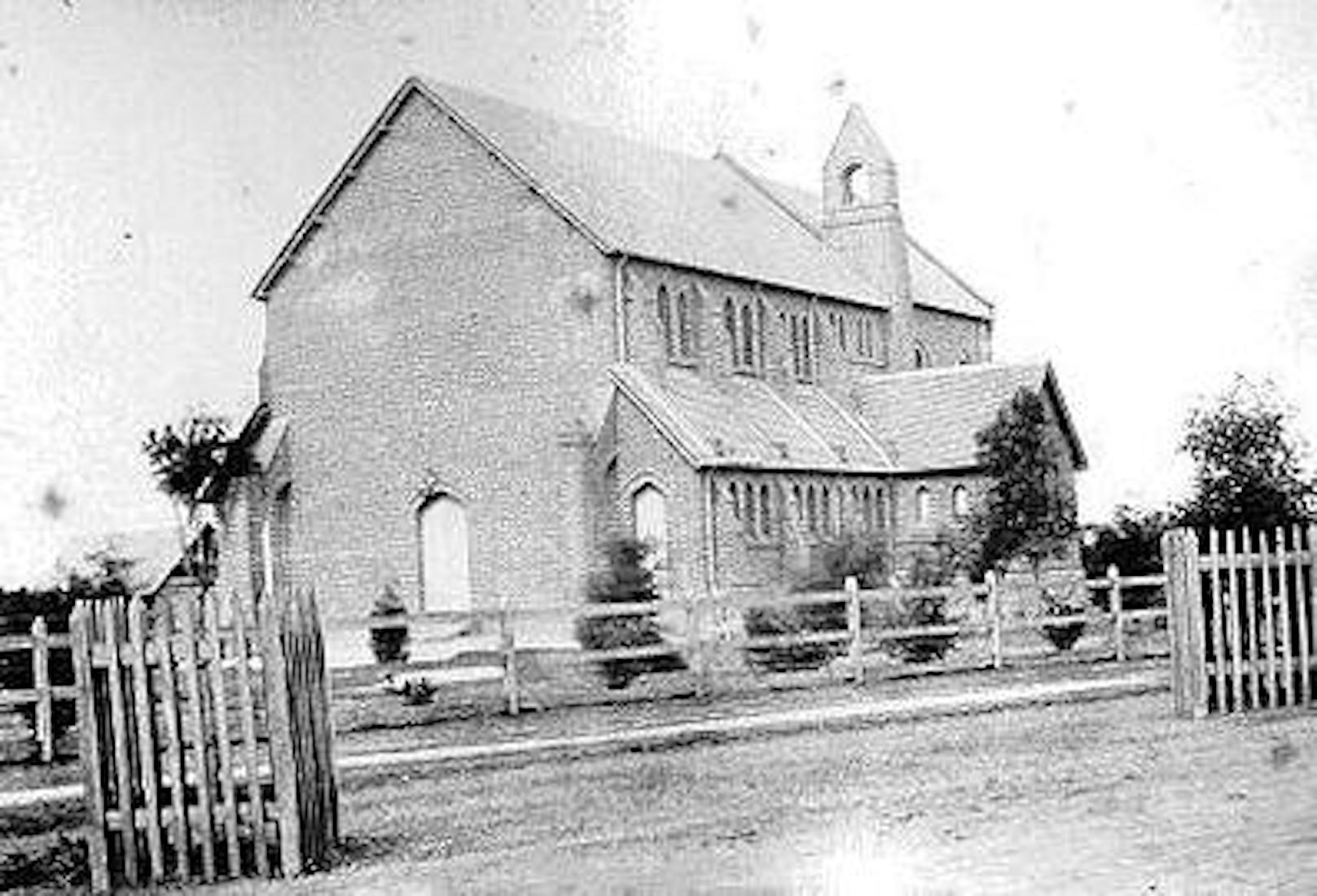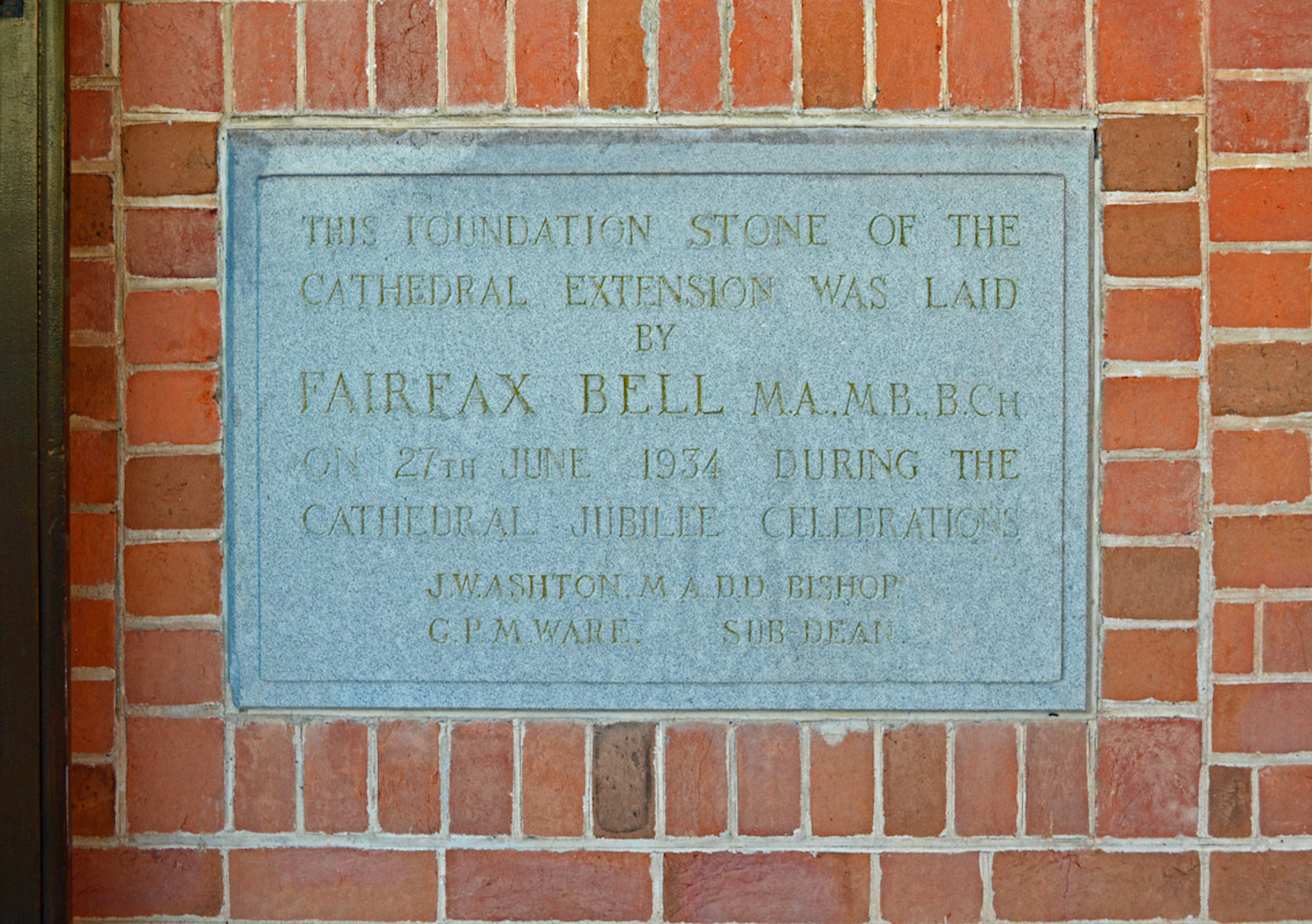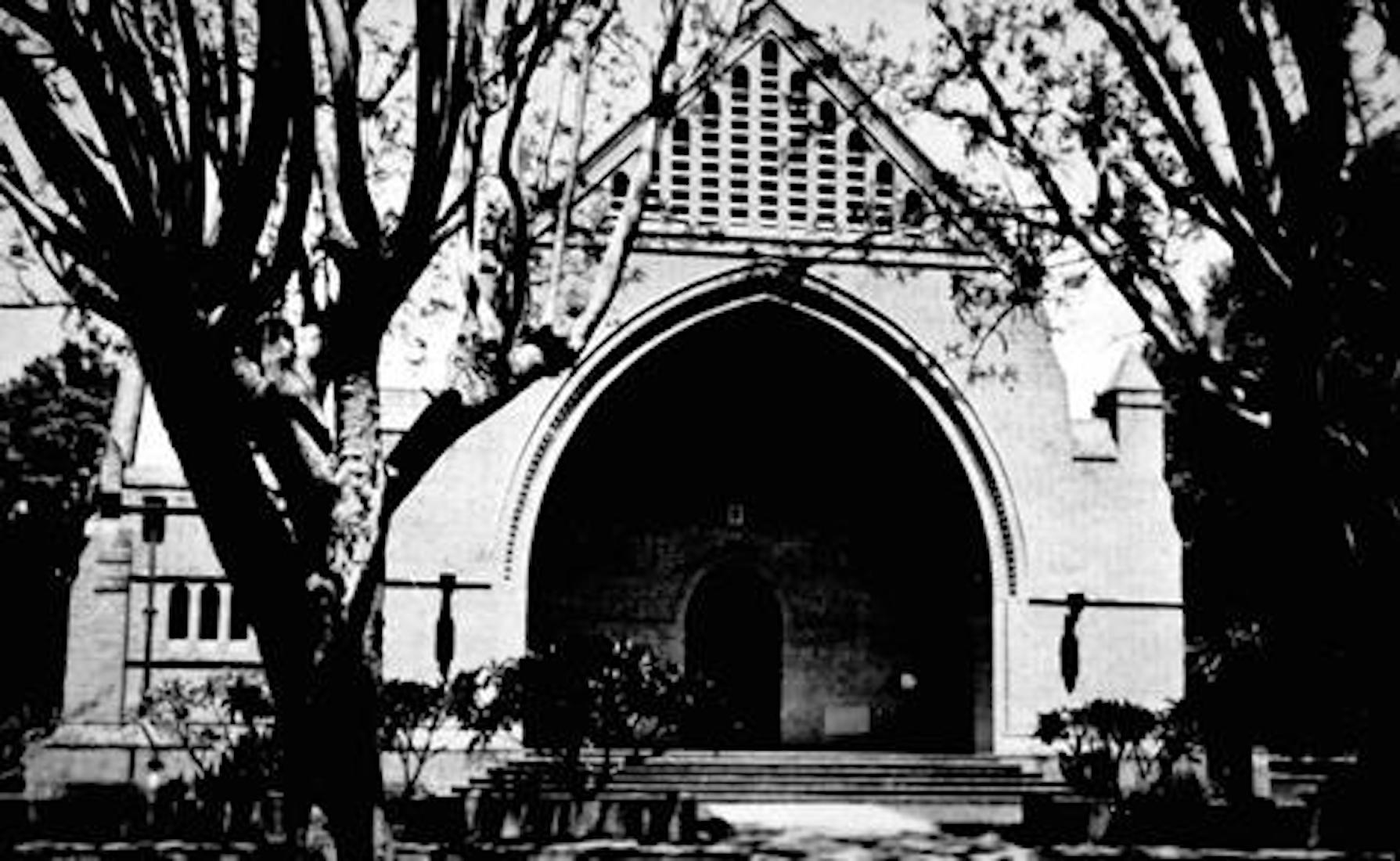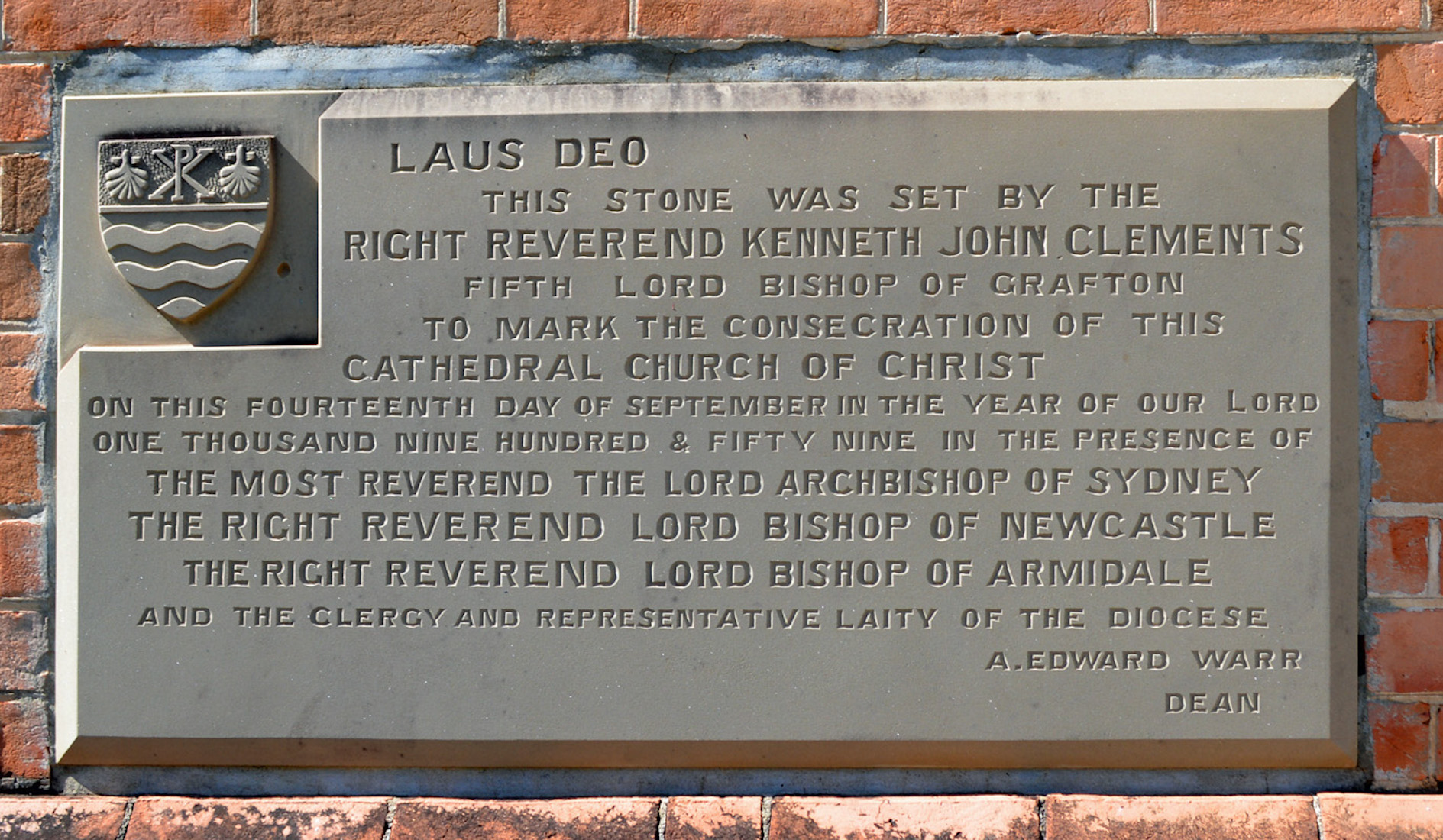
This mosaic tiling in the chancel / quire area is of interest because it reflects the progressive construction of the cathedral. Earlier, smaller tiles can be seen top right; later tiles were larger in size. PLAN
42. BRASS PLAQUE AND ANCIENT STONE
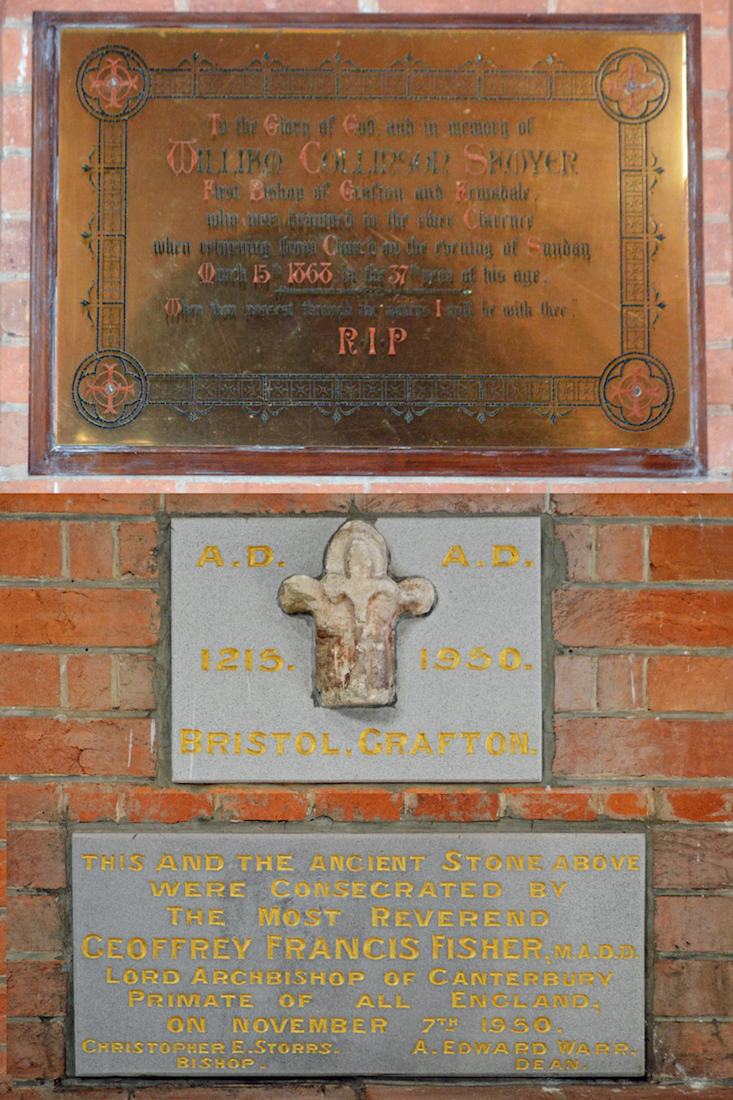
Rounding the column towards the expected South transept, we find another stone fragment, this one from Bristol Cathedral, dating ca 1215 AD, and set here in 1950. The link with Bristol was first established by the first Dean of Grafton, Dean A. Edward Warr, a native of that city. There is also a brass plaque in memory of William Collinson Sawyer, the first Bishop of Grafton and Armidale, who died in 1868.
43. DEAN’S CHAIR
As we move towards the South nave, we pass the dean’s stall with the symbol we have discussed earlier: the Chi Rho symbol with crown, celebrating Christ as King.
45. SOUTH AISLE WINDOWS I
The Eastern-most windows in the South aisle depict (from left): • I am the Light of the world (Jn 8:12) (a replication of the famous painting by Holman Hunt); • Behold an Israelite in whom is no guile (Jn 1:47); • Dorcas (Acts 9:36). The windows are given in memory of Frederick and Elizabeth Doberer, Charles Capel Greenway (Vicar of Grafton for 17 years), and Daria Leonard Stemfen-Lowe. • The next set of windows depict: • Lord now lettest thy servant depart in peace (Lk 2:22) – words of Simeon; • Jesus and Nicodemus (Jn 3:1); • Watch and pray (Matt 26:36) – Jesus in the Garden of Gethsemane. These windows were given in memory of Jane Schwinghammer, Clarence and Arthur Schwinghammer, and George and Catherine Greenaway.
46. SOUTH AISLE WINDOWS II
The central windows on the South aisle depict: • The Presentation of Christ in the Temple (Lk 2:22); • St Philip the Deacon – Philip is a first century saint, one of the seven deacons ordained by the apostles; • St John the Baptist . These windows are given in memory of Thomas Hawkins Smith (died 1902), Reginald Walter Stockdale (died 1904) and Arthur Edward Selwyn M.A. (Priest in charge of this Parish 1853 – 1867). • The next windows as we move towards the West wall show: • Who is my neighbour? (Lk 10:33); • The Virgin Mary with Jesus and John the Baptist; • St Cecilia (a third century saint who has been the patron saint of music since the 16th Century). These windows are in memory of Percy Sanders and Emily Sanders, Joan May Sanders, and Edgar Harold Strauss (1901 – 1984).
47. SOUTH AISLE WINDOWS III
The next three windows show: • Peace be unto you (Lk 24:36) – Jesus appears to his disciples after his Resurrection; • He took bread, blessed and broke it (Lk 24:30) – Jesus appears to Cleopas and friend; • Come and have breakfast (Jn 21:12) – Jesus after his Resurrection. These windows are given in memory of Carl Schaeffer (1909 – 1991), Nancy Schaeffer (1913 – 1996) and their daughter Valerie (1938 –1995); Angus Warwick Wild (23.2.1970 – 9.10.1994); and Rohan David Feltham (1969– 1987).
48. WEST WINDOWS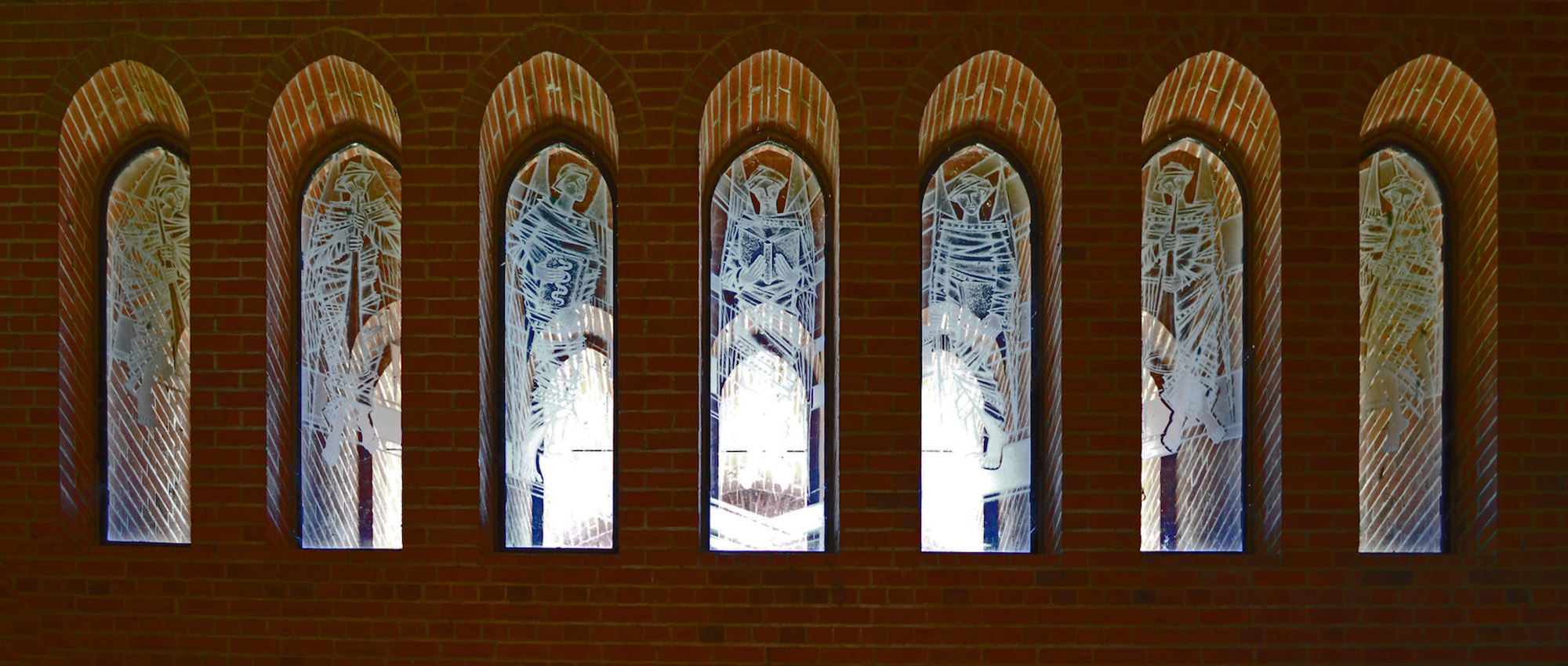
Above the West doors are the Bishops’ Memorial Windows. These seven windows crafted by Paddy Robinson were dedicated in 1995, and were modelled on windows from Coventry Cathedral in England. They are memorials to former Bishops of Grafton. They are contemporary, acid etched and engraved in laminated glass. They show angels blowing trumpets and carrying the gospels. The windows show the archangels Gabriel, Michael, Uriel and Raphael.
49. WINDOWS DETAIL
The windows are difficult to photograph, but this photo shows something of the detail.
50. DOLLS
Just inside the West doors on the South side, is a little porcelain doll in a glass case. There is quite a story here ... . Funds were being sought to build the edifice in 1883. Bella and May Greenaway were the small daughters of the clergyman of the diocese, and each possessed a small porcelain doll. Just a simple little white rigid doll, with painted hair and lips, about ten or twelve centimetres high. One of the daughters, Bella, insisted on donating her doll to the cause, and it was accepted and placed somewhere in the walls of the new cathedral. When part of a wall was demolished in 1937, in order to facilitate the extension that was taking place, the doll was found in the cavity. It was removed, cleaned and placed in the new West wall where it can be seen today, albeit with some difficulty. ... • The Greenaways remained in Grafton, some descendants still living in the old home. Grafton is like that, full of lovely old homes built around Federation or before. When a relative, for some reason or another was moving some heavy furniture, she discovered the other identical porcelain doll wedged behind a solid wardrobe. No doubt it had belonged to May. This doll was also cleaned up, and given to the Cathedral in 1984, over a hundred years since the other doll had been so generously donated. May’s doll is to be found inside, to the right of the imposing entrance, housed in a glass-fronted frame, for all to see. Oh that the doll could speak! https://www.graftoncathedral.org.au/cathedral-dolls . This completes our tour of Grafton Cathedral, but some historical photos follow.
51. ORIGINAL CHURCH
Anglicans have been worshiping in Grafton since 1842, initially in a wooden church which was located in the present Cathedral Close. The bell tower was moved in 1884 from its original site to its present position near the Cathedral. The Diocese of Grafton and Armidale was formed in 1863, and the first Bishop, William Sawyer settled in Grafton in 1868. He unfortunately drowned two days later and Bishop James Turner was appointed to succeed him. Unless otherwise stated, the historic photos on these pages come from Cathedral sources.
52. ARCHITECT’S DRAWING
Christ Church Cathedral in Grafton was completed in 1884, during the episcopacy of Bishop Turner. It was designed by John Horbury Hunt, a sometimes controversial architect, whose other work in northern New South Wales includes St Peter’s Cathedral in Armidale. Hunt’s forté was building in brick, influenced by English country houses. The architect’s drawings show a tower and a spire, neither built – yet!
53. STAGE I
The first stage of construction of the Cathedral included the sanctuary, vestries, and the Eastern half of the present nave. This was to serve the Grafton congregation as a centre of worship for the next fifty years. In 1914 the Diocese of Grafton and Armidale split, and the Grafton Diocese was formed. Today the Diocese has 26 parishes, an active environment commission and an Anglicare organisation seeking to support community and social needs within the diocese.
54. 1934 STONE
It was not until fifty years later in 1934 that the foundation stone for the second stage of the Cathedral was laid. There are a number of memorial stones and plaques in this Cathedral.
55. WEST WALL 1945
There is not a lot of easily accessible material on the building of the Cathedral but this photograph from the State Library of Victoria shows that the present Cathedral was finished by 1945. [Photo Credit: slv : MM8630 : 1945]
56. 1959 WEST WALL STONE
The Cathedral was not consecrated until 1959. In September of that year, the current Bishop of Grafton, Right Reverend Kenneth John Clements performed the ceremony in the presence of other senior clerics, representing the Australian Dioceses which were part of Grafton’s history. Since this time, various improvements have been made, including purchase of a new organ in 1990, and the installation of the Bishops’ windows in 1995. This completes our tour of the Cathedral.
CONCLUSION
I hope you have enjoyed visiting Christ Church Cathedral, Grafton with me. There is a lot of history here!
I am happy to receive constructive comments or corrections concerning this website. The best websites are the ones which have no errors! I am grateful to my wife Margie who came to Grafton with me, and who has proof-read these pages.
The text on this site draws heavily on the Cathedral publications ‘Guide to the Cathedral’, and ‘A Guide to the Stained Glass Windows’ compiled by Robbie Coulton. I am happy to acknowledge these sources.
The link for the Cathedral website is:
http://www.graftoncathedral.org.au
My photographs which appear on this site can also be found in higher resolution at:
https://www.flickr.com/photos/paulscottinfo/albums/
Site created 06 / 2013; reformatted 04/ 2019, 09 / 2020.
Paul Scott
